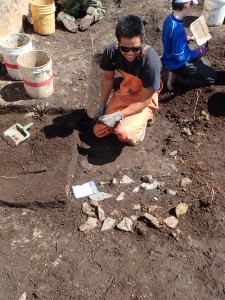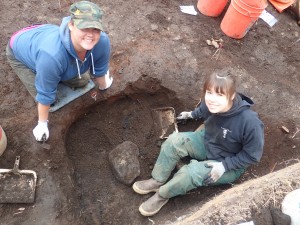Literally.
Rachel Gill back again to talk more about our site specifically and the journey into forming and testing a hypothesis. Science at work!
For the past two weeks, the Community Archaeology team has been agonizing over what the heck is going on in the vast 5×5 grid excavation affectionately named “Block B”. Patrick and Catherine, our intrepid co-leaders, have toyed with a series of hypotheses, which culminated in the complicated excavation of a series of smoking pits.
But that conclusion was hard-won; let me take you through our two-week journey into the pits of Block B.
Initially, maybe a year or two ago when the study was in its infancy, a geologist used ground penetrating radar (GPR) to see if the main excavation extended past a series of trees. They found a depression beneath the sods, so naturally, the archaeologists thought house. And that’s exactly the mindset we had when we stuck our shovels into the sod. The sheer amount of the first layer of ash, called Katmai, and how deep it was in some areas, was encouraging. It got deeper in the middle and was shallow on the outsides and all of that basically screamed house.
At least for the first three hours.
 Block B just after the sod and Katmai ash was removed
Block B just after the sod and Katmai ash was removed
and before the real excavation started
As we dug deeper into the ash, a series of mounds started to take form. So, people started to change their hypotheses; someone said it was a house with multiple rooms while others thought it may even be more than one house. One boy even joked that they were some kind of burial mounds, eliciting a cry of dissent from the crew. We left the first day all speculating.
In the days to come, a few things started to take shape. In two opposite corners of the excavation, our team found two rock features. (Another brief vocab lesson: a feature carries evidence of human activity like a hearth or a wall.) The one on the east end was larger than the other, with a series of rock piles in the middle of a pit of charcoal-stained soil. The west end had smaller rocks and less charcoal, so it seemed that the two-house theory might have support. We called this gravel layer Level 1A g (creatively, for gravel!).
 Alutiiq Museum intern Jesse kneeling next to
Alutiiq Museum intern Jesse kneeling next to
the smaller rock feature
It turned out that this thick, gravelly layer of charcoal-stained earth (L1Ag) actually seeped beneath other layers. Level 2A, the thick orange ash that dates to 3800 years ago, was actually on top of our L1Ag. This bizarre shift in stratigraphy forced us to reevaluate our “hearth” theory.
 Students Alexandria and Jeannine excavate the
Students Alexandria and Jeannine excavate the
larger rock and charcoal feature
That was when Patrick thought about a smoke pit; according to him, they are some of the most common sites around Kodiak. The 3800 year-old ash that covers the L1Ag gravel-charcoal layer is mixed with darker brown soil, which made him think that perhaps there was one very large smoke pit covered with a roof made out of sod and ash. At one point or another the roof collapsed inward, possibly in a fire, covering the charcoal and rock underneath. For this to be true, we would eventually find a soil basically the color of bright orange Cheeto dust, which would indicate this severe burning.
The charcoal layer kept expanding, but no Cheeto dust.
Finally, the bizarre stratigraphy started to make sense when Patrick suggested that some of the ash layer may have been dug up and redeposited. Eventually, after a massive discussion, we came the conclusion that it’s possible that one very large pit had been dug, used, covered when the ash fell, and then more smoke pits were dug after the ash fell. It’s possible that these smoke pits were dug in contemporary periods or two entirely different sets of people used the same place for a smoking pit. (This is very much still up in the air and undecided amongst the crew.)
 Student Rachel crouches in the extended smoke pit – note the charcoal-rich L1Ag at her feet, and the 3800-year old ash fall (L2) that covered the pit.
Student Rachel crouches in the extended smoke pit – note the charcoal-rich L1Ag at her feet, and the 3800-year old ash fall (L2) that covered the pit.
Still, we have one more week to excavate and perhaps our hypothesis will change or alter once more. Because that’s the nature of this kind of investigation: as your evidence changes, your hypothesis is tested and may be challenged. And absolute certainty is a difficult thing to achieve, but the possibility is always there.
Sometimes archaeology is the pits. But it’s the pits that always make it interesting.